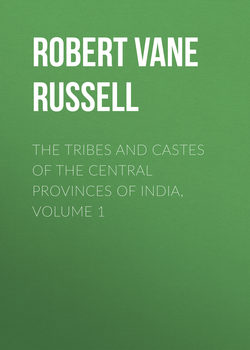Читать книгу The Tribes and Castes of the Central Provinces of India, Volume 1 - Robert Vane Russell - Страница 1
ОглавлениеPolitical Divisions of the Indian Empire
Scale = 1 : 17,500,000
Central Provinces and Berar
Scale = 1 : 4,000,000 or 63.1 Miles to an Inch
Main Linguistic or Ethnical Divisions of the Central Provinces with the Sambalpur District and Certain States now in Bihar and Orissa
Scale = 1 : 4,000,000 or 63.1 Miles to an Inch
HINDI-speaking Districts.—The western tract includes the Saugor, Damoh, Jubbulpore, Narsinghpur, Hoshangabad, Nimar and Betul Districts which lie principally in the Nerbudda Valley or on the Vindhyan Hills north-west of the Valley. In most of this area the language is the Bundeli dialect of Western Hindi, and in Nimar and Betul a form of the Rajputana dialects. The eastern tract includes the Raipur, Bilaspur and Drug Districts and adjacent Feudatory States. This country is known as Chhattisgarh, and the language is the Chhattisgarhi dialect of Eastern Hindi.
MARATHI.—Amraoti, Akola, Buldana and Yeotmal Districts of Berar, and Nagpur, Bhandara, Wardha and Chanda Districts of the Nagpur Plain.
TELUGU.—Sironcha tahsil of Chanda District. Telugu is also spoken to some extent in the adjacent tracts of Chanda and Bastar States.
TRIBAL or Non-Aryan dialects.—Mandla, Seoni, Chhindwara, and part of Balaghat Districts on the Satpura Range in the centre. Sarguja, Jashpur, Udaipur, Korea, and Chang Bhakar States on the Chota Nagpur plateau to the north-east. Bastar and Kanker States and parts of Chanda and Drug Districts on the hill-ranges south of the Mahanadi Valley to the south-east. In these areas the non-Aryan or Kolarian and Dravidian tribes form the strongest element in the population but many of them have abandoned their own languages and speak Aryan vernaculars.
URIYA.—Sambalpur District and Sarangarh, Bamra, Rairakhol, Sonpur, Patna and Kalahandi Feudatory States. This area, with the exception of Sarangarh, no longer forms part of the Central Provinces, having been transferred to Bengal in 1905, and subsequently to the new Province of Bihar and Orissa. It was, however, included in the ethnographic survey for some years, and is often referred to in the text.
